The almost forgotten technique in the UK of grazing cereals is something being widely practiced across Australia in areas with widely varying rainfall levels. The Australian Grain Research and Development Council have produced a report titled Grain and Graze which sets out to evaluate the advantages and disadvantages of grazing a range of cash crops. We begin serializing this report over forth coming issues to explore what is currently an untapped resource.
In Direct Driller Issue 3 we started looking at the potential opportunities of grazing winter crops. One of the greatest downsides is the risk of potential reduction in grain production and value due to grazing. This is where we pick up our content on grazing winter crops.
The Possible Costs (the downside)
The greatest downside risk is the potential reduction in grain production and value due to grazing. Results from Grain and Graze and other experiments show a wide range of yield and quality responses to grazing, from large reductions in grain yield to no yield losses or even increases in yield. Reduction in grain yield Grain yield data from 2004 to 2013 was collected across 53 cereal trials and 246 measurements in Western Australia, South Australia and Victoria where a grazed and ungrazed comparison could be measured (figure 1). This included wheat, barley, triticale and oats. The results also include treatments where grazing was less than ideal, including grazing after stem elongation and when crops were under stress. These extreme treatments were imposed to appreciate the size of the yield and quality loss under adverse conditions.
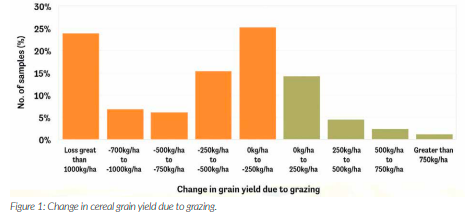
Figure 1 highlights several key points:
• Cereal grain yield declined under grazing most of the time crops were grazed (78%), although the severity of the decline varied. The most common result was a yield decline of less than 250 kg/ha (25% of cases), with yield loss of between 250 kg/ha and 500 kg/ha occurring a further 15% of the time.
• Increases in grain yield were recorded in 22% of cases. The most common increase was up to 250 kg/ha although some larger gains were also recorded. The main reasons for the gains were attributed to reductions in lodging and less leaf disease, both a consequence of the removal of early growth by grazing.
• Large losses in grain yield were recorded (24% of cases). Four factors are believed to contribute to the large yield decline (table 2).
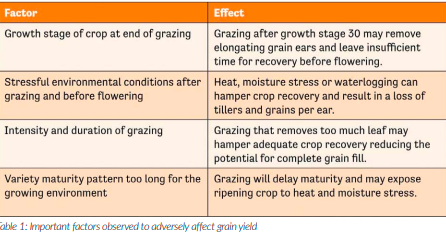
Canola
Grain data for grazed canola was limited. Most of the information was collected from Southern Victoria when the crop was sown at the conventional sowing time (late April to early May). Dry matter production was generally lower than cereals sown at the same time and the crop was slower to recover from grazing. This resulted in severe yield penalties. Best practice sowing guidelines for canola are to sow in Late March to early April, but this may be difficult to achieve in some areas because of stubble burning restrictions and weed control.
However, the availability of new canola varieties with strong winter habit provides the opportunity to sow by taking advantage of out of season rainfall (October through to February), where the crop is treated like a brassica fodder for grazing before being locked up and taken through for grain. Changes to grain quality Grazing resulted in a variable response to cereal grain quality. In some trials grazing improved grain quality characteristics, in other trials grain quality declined. The general conclusions from the spread in results are discussed. Protein Grazing did not affect the average grain protein in wheat but did with barley. Of the 64 wheat results examined, the average change in wheat protein from grazing was -0.1%, with a similar number of increases in protein recorded as decreases (figure 2).
The grain protein response to grazing for barley was different, with grazing more commonly resulting in a decline in grain protein (65% of the time). The average decrease across all trials for barley was 0.3% (figure 3). The reasons for the decline in grain protein with grazed barley is not obvious. The results used in the analysis were collected across many years, using different varieties, nitrogen applications and time of grazing. This makes it difficult to identifying the possible reasons for changes in grain protein. The only loose association from the information is between grain yield and protein. It appears if grain yield is increased because of grazing, which happened in 40% of all the barley trials, then grain protein decreased (i.e. was diluted).
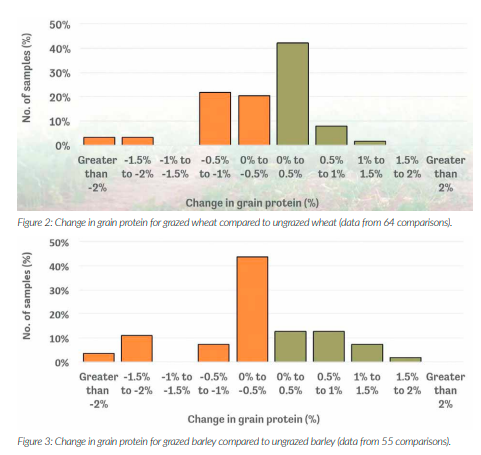
Grain size
Grain size in wheat and barley was generally not affected by grazing. Of the 54 comparisons with wheat and 42 comparisons with barley, slightly more than half the observations showed a reduction in grain size due to grazing. The average reduction in wheat was 1% and 2% for barley. The limited (less than 10) observations of grain size for triticale and oats showed similar responses to grazing as wheat.
Screenings
Screenings increased slightly for both wheat and barley as a result of grazing. More than 73% of wheat and 68% of barley comparisons showed an increase in screening compared to no grazing (figures 4 & 5). The average increase in screenings for wheat was 0.9% and 1.4% for barley. There was a slight correlation between increasing screenings and a reduction in yield after grazing.
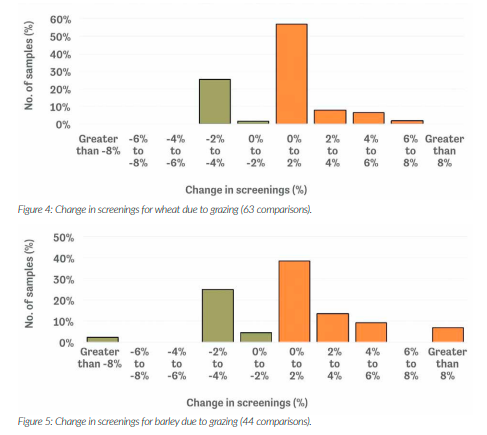
Calculating the value of grazing crops
Calculating the value from grazing winter crops can be challenging because while there are immediate benefits through feed for livestock, the flow on effects are often more difficult to quantify. These flow on effects may include potential grain yield loss from grazing, building a ‘feed wedge’ because pastures can be spelled and making different livestock management decisions. The gains are realised within the farming system and not simply by comparing the potential loss of grain yield with the livestock gain when the crop is grazed.
Modelling undertaken by the CSIRO2 would suggest the potential benefits to whole farm profitability are very significant, in the order of AUS$100/ ha to AUS$200/ha. Attention to variety selection, early sowing, adopting best grazing practice and increasing stocking rate are all required to achieve this potential. Individual farm considerations such as weed and disease issues, chances of favourable climatic conditions to enable early sowing, adequate farm infrastructure and cash flow to run more livestock and the manager’s position on risk may temper these potential benefits.

The Fowler family from East Esperance in Western Australia started grazing crops in 2008 as a trial before fully incorporating into their farming system in 2010. In 2011 they cropped 10,000 ha of wheat, barley and canola, of which more than half of that was grazed. Andrew Fowler said grazing crops had delivered a major lift in the profit of their operation and that it was one of the best innovations they had implemented on the farm. “We first tried it to make the pasture phase of our rotation more profitable and comparable with the cropping phase,” Andrew said. “Previously we were looking at about $200/ ha gross profit for livestock which wasn’t much when we compared it to cropping, which was about $500/ha.

“We needed to lift our stocking rate to increase our return per hectare to make grazing worthwhile, as well as to help recover some of the fixed c o s t s associated with livestock and m a i n t a i n i n g p a s t u r e paddocks.” By using grazing crops, the Fowlers have now managed to lift the pasture phase to $350/ ha gross profit and nearly double their stocking rate from 10 DSE (dry sheep equivalent) to 18 DSE. In 2010 they increased their net profit by $500,000 by growing an extra 1,000ha of crop and retaining their livestock numbers. “Grazing crops is a really important tool in matching the supply of feed to livestock demand, and it has helped the farming business to harness the synergies between livestock and crops” Andrew said. “As a result we have had some great benefits with liveweight gains, higher stocking rates, cost savings, crop management advantages and more: all with little impact on crop yields at harvest”.
Benefits of grazing crops
“Grazing crops significantly reduces the levels of disease in barley (especially powdery mildew) when compared with ungrazed crops, which eliminates the need for an early fungicide spray,” Andrew said “In our canola crops, the height of the crop is shortened which makes swathing and harvesting a lot easier. In 2010, the height of the crop dropped by a foot as a result of grazing.” Yield and quality are not compromised as a result of grazing. In 2010 the Fowlers’ highest yielding paddocks were grazed, a wheat heat paddock went 4.7 t/ha and a grazed canola paddock yielded 2.1t/ha. The quality was excellent with 45% oil and 0.6% admixture.
Andrew said an additional benefit is less grain is required for supplementary feeding. We wouldn’t be able to maintain our livestock numbers if we didn’t graze our crops. “We would have to feedlot the sheep and cattle, or decrease our numbers which would reduce the profitability of our pasture phase and this was the main reason for heading down this path in the first place”. The Fowlers have had excellent live weight gains from grazing crops. For sheep, they average about 300 grams/ head/day and 1.8 kilograms/head/day for cattle. In 2011, their drop of crossbred Merino White Suffolk lambs only spent five days grazing pasture before the first draft was sold on 8th August at 18.1 kg for $118 a head. (The rest of their lives were spent grazing crops.) The ewes lambed in stubble before grazing a barley crop at the three leaf stage. The lambs were weaned at six weeks, the ewes were sold, and the lambs continued to graze crops.
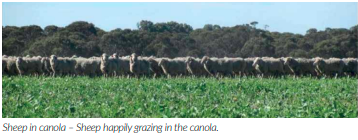
Challenges
Andrew said at the start, the hardest part was to open the gate and let the stock into a good looking crop, but he was amazed how quickly the crop recovered. Other challenges the Fowlers have faced and, that Andrew stressed, were very important for the system to work, include:
• the early seeding of crops
• good weed control
• a good rotation.
• providing ad-lib straw for livestock, and
• not over-grazing the crops, with the best results achieved if there is some biomass left after grazing.
Crop stages and management
Livestock are removed from crops at the first hollow stem (around Zadocks GS 30) in cereals, and with canola, stock are removed when the buds are about 10cm high and there are a few leaves left. “The best results are achieved when you don’t take all the biomass away – you can graze to the white line (when there is no green left) but we have found that the crop is a lot slower to recover if you do this,” Andrew said. They have found the early sown crops handle grazing well, but the flowering date of the later sown crops is pushed back a bit too far (and the yield affected) without careful grazing. The Fowlers finish grazing most paddocks by end-July and the latest date is early-August. After livestock are removed, the Fowlers immediately spray with a Nitrogen (N) application.
Once a new leaf has fully emerged, barley crops are sprayed with a broadleaf and powdery mildew spray, and Roundup Ready Canola is sprayed (being careful to manage withholding periods if crops are to be grazed postspraying). The Fowlers admit the big advantage for them is the lack of frost occurrences in the region, which allows their crops to recover quickly.
Pasture tips
The Fowlers continue to strategically rest and graze their pasture paddocks while grazing crops. “We don’t lock up our pasture paddocks otherwise the cape weed gets away on us,” Andrew said. “If we continue to use our pastures, we find that it increases the quality and quantity of feed for August when we start full time grazing.
